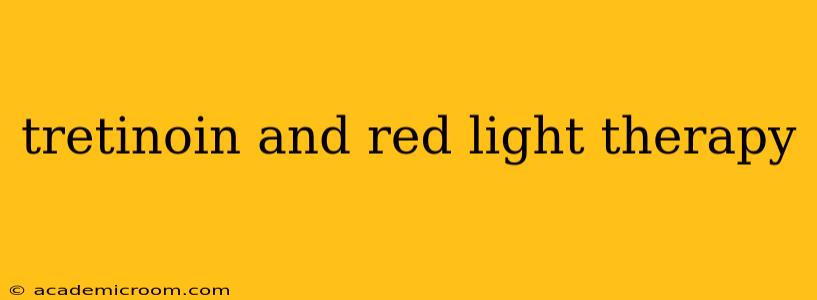Tretinoin, a topical retinoid, and red light therapy are both popular treatments for various skin concerns. While often used independently, combining them may offer synergistic benefits for skin rejuvenation. This article explores the individual effects of each treatment, potential benefits of combining them, and important considerations before embarking on this skincare regimen.
What is Tretinoin?
Tretinoin, a derivative of vitamin A, is a potent retinoid prescribed by dermatologists to treat acne, wrinkles, hyperpigmentation, and other skin conditions. It works by increasing cell turnover, promoting collagen production, and unclogging pores. This leads to smoother, clearer skin with a reduction in fine lines and age spots. However, tretinoin can cause side effects like dryness, redness, peeling, and increased sun sensitivity. It's crucial to start with a low concentration and gradually increase it under the guidance of a dermatologist.
What is Red Light Therapy?
Red light therapy (RLT), also known as photobiomodulation, uses low-level red or near-infrared light to stimulate cellular processes in the skin. This light penetrates the skin's surface, boosting collagen and elastin production, reducing inflammation, and improving blood circulation. RLT is considered a safe and non-invasive treatment with minimal side effects, often leading to improved skin texture, reduced wrinkles, and a healthier complexion. The wavelengths of light used are crucial for effectiveness; typically, wavelengths between 630-700nm are used for skin rejuvenation.
Can You Combine Tretinoin and Red Light Therapy?
While there's no definitive clinical research specifically on the combined use of tretinoin and red light therapy, the potential benefits are promising based on their individual effects. The combination could theoretically amplify the positive outcomes. Tretinoin's increased cell turnover could create a more receptive environment for the stimulating effects of RLT, potentially accelerating collagen production and skin repair.
What are the Potential Benefits of Combining Tretinoin and Red Light Therapy?
- Enhanced Collagen Production: Both tretinoin and RLT stimulate collagen synthesis. Combining them could lead to significantly improved collagen production, resulting in firmer, more youthful-looking skin.
- Improved Skin Texture: The increased cell turnover from tretinoin, combined with the anti-inflammatory and circulatory benefits of RLT, could lead to smoother, more even skin texture.
- Reduced Wrinkles and Fine Lines: The synergistic effects on collagen production could lead to a more noticeable reduction in wrinkles and fine lines compared to using either treatment alone.
- Faster Healing and Reduced Inflammation: RLT's anti-inflammatory properties might help mitigate the initial irritation and dryness often associated with tretinoin, potentially speeding up the healing process.
Does Red Light Therapy Help with Tretinoin Side Effects?
While RLT might help reduce some inflammation associated with tretinoin, it's not a guaranteed solution. The dryness and peeling are still likely to occur, especially when initially starting tretinoin. It's crucial to follow your dermatologist's instructions regarding tretinoin usage and to use a good moisturizer to combat dryness.
How Often Should You Use Red Light Therapy with Tretinoin?
There's no established protocol for combining these treatments. A dermatologist can guide you on the optimal frequency for both, considering your skin type and sensitivity. Generally, it's recommended to apply tretinoin at night and use RLT on alternate days or as directed by your physician. Avoid using RLT immediately after applying tretinoin, as this may increase sensitivity.
Is it Safe to Combine Tretinoin and Red Light Therapy?
Generally considered safe when used appropriately and under the guidance of a dermatologist. However, individual skin reactions can vary. Start slowly with both treatments to monitor your skin's response. If you experience significant irritation or adverse reactions, stop the treatment and consult your dermatologist.
What are the Potential Side Effects of Combining Tretinoin and Red Light Therapy?
Potential side effects are mainly those associated with tretinoin, such as dryness, redness, peeling, and increased sun sensitivity. RLT generally has minimal side effects, but some individuals may experience mild redness or warmth. Always monitor your skin closely and consult a dermatologist if you have concerns.
Conclusion
The combined use of tretinoin and red light therapy holds potential for enhanced skin rejuvenation, but it's vital to proceed cautiously and under professional guidance. A dermatologist can assess your skin type, concerns, and medical history to determine if this combination is appropriate for you and develop a personalized treatment plan. Remember, consistency and patience are key to achieving optimal results.
